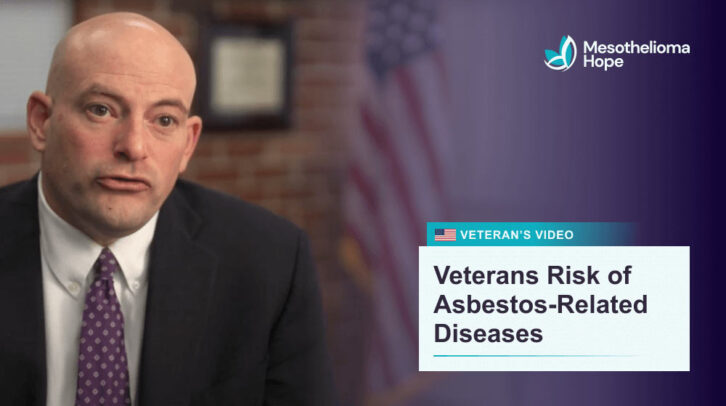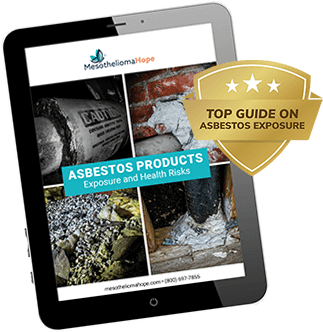What Is Asbestosis?
Asbestosis is a lung disease that occurs from breathing in asbestos fibers.
When a person inhales microscopic asbestos fibers, the fibers lodge in the inner lung tissue and attach like Velcro to the alveoli (tiny air sacs).
The body’s immune system can’t break down asbestos fibers as it does other impurities. As a result, asbestos particles cover the lung interior and stay there permanently. The body’s natural response is inflammation and scar tissue formation over the trapped asbestos fibers.
Eventually, this mass of scar tissue thickens and hardens. It causes the lungs to stiffen, making normal expansion and contraction difficult or impossible.
Asbestosis doesn’t metastasize or spread like cancer tumors. Rather, the scarring of lung tissue makes breathing so difficult that the asbestosis victim can suffocate. This lung condition also stresses other body functions and can send a patient into organ failure or cardiac arrest.
Fast Facts About Asbestosis
- As with other asbestos-related diseases, asbestosis symptoms may appear 10-50 years after the initial exposure.
- Asbestosis is a progressive disease, which means it gets worse over time.
- People at risk for developing asbestosis are those who worked in construction, shipbuilding, or other industries in which asbestos products were common before asbestos bans in the 1980s.
- No treatment can reverse the lung damage caused by asbestosis.
- Patients with asbestosis are 8-10 times more likely to develop lung cancer than people without the disease.
Asbestosis Symptoms
Asbestosis is a lung disease directly related to asbestos exposure that can cause dangerous symptoms. Even though it remains benign (noncancerous) in the lungs, it is a serious disease.
The worst thing about asbestosis is the pain and discomfort from the symptoms.
Asbestosis symptoms include:
- A persistent dry cough
- Chest pain
- Crackling sound in the lungs when breathing in
- Loss of appetite resulting in weight loss
- Shortness of breath
- Swelling of fingertips and toes (clubbing)
Asbestosis symptoms appear 10-50 years after the initial asbestos exposure.
People with a history of asbestos exposure and experiencing shortness of breath or other asbestosis symptoms should schedule a visit with their health care provider.
Our Free Symptoms Checklist can help you track your symptoms, share them with your doctor, and get an accurate diagnosis.
Diagnosis of Asbestosis
Doctors diagnose asbestosis by reviewing a patient’s medical history and performing several diagnostic tests. Discussing a history of asbestos exposure is a primary diagnostic step.
A medical professional may hear a crackling sound when using a stethoscope to listen to a patient’s breathing.
Doctors typically rely on these tests to diagnose asbestosis:
- Chest X-rays: Advanced asbestosis shows up as excessive whiteness in lung tissue. In severe cases, the lungs look like honeycombs.
- CT scans: These scans are more detailed than a standard X-ray and can detect asbestosis in the early stages, even before it appears on a chest X-ray.
- Lung function tests: Breathing tests can help determine the severity of asbestosis in a patient.
Once a diagnosis is confirmed, disease management plans can begin. Cancer treatments like radiation and chemotherapy don’t work with asbestosis.
Asbestosis Treatment Options
While there is no cure for asbestosis, there are steps patients can take to slow down the progression of this lung disease, ease symptoms, and prevent complications.
First, patients should stop smoking. Studies conclusively show that smokers were at least 50 times more likely to develop asbestosis than non-smokers. Continued smoking helps asbestosis to progress.
Doctors may prescribe these asbestosis treatments:
- Oxygen therapy: A patient receives oxygen supplied by a tank.
- Pulmonary rehabilitation: This exercise program helps patients with chronic lung conditions remain active and enjoy a good quality of life.
- Surgery: In severe cases, patients may need lung transplant surgery.
Asbestosis patients can keep themselves healthy by eating right, staying active, and getting enough sleep. They should stay inside when pollen counts, and air pollution levels are high.
In addition, exposure to secondhand smoke and other pollutants can cause shortness of breath.
Who Is at Risk Of Developing Asbestosis?
Most people suffering from asbestosis were exposed to asbestos before the mid-1980s. That’s when federal regulatory authorities like the Occupational Safety & Health Administration (OSHA) worked to have asbestos-containing products banned from worksites.
Unfortunately, these safety regulations came too late for asbestosis victims. Many people still suffer from asbestosis and eventually die from associated complications.
Asbestos was widely used in the United States across many industries, including construction and shipbuilding. Occupational asbestos exposure placed millions of American workers and military service members at risk of asbestosis and other asbestos-related diseases.
The highest recorded asbestosis cases occurred in shipyard workers and sailors who lived on and operated vessels loaded with asbestos materials. The U.S. Navy reported more asbestosis disease incidents per working capita than any other military or civilian segment.
U.S. veterans who were exposed to asbestos could develop diseases like mesothelioma, asbestosis, and lung cancer decades later. Call (866) 608-8933 to get help after a diagnosis. View Transcript.
Duration: 1 min 01 sec
Veterans who served in the military between the 1930s and the 1980s were likely exposed to asbestos while they were on active duty.
Usually, if you’ve developed an asbestos-related disease, you developed that disease because you had an excessive amount of exposure to asbestos.
If a veteran believes they were exposed to asbestos while serving in the military, we encourage them to call MesotheliomaHope.com so that we can work together to help them file for VA benefits.
The VA will recognize any asbestos-related disease as long as your asbestos exposure happened while you were on active duty in the military.
In addition to VA benefits, MesotheliomaHope.com can connect veterans with world-renowned physicians and nurses on staff that can answer any of your treatment questions. We encourage veterans to call and find out how we can help them.
Construction workers also had an extremely high rate of asbestosis. They worked with asbestos products while building homes, schools, offices, and factories. Practically every construction material made between 1920 and 1980 contained asbestos fibers.
A 45-year study of nearly 140,000 motor vehicle mechanics published in the medical journal Thorax in July 2021 found that mechanics had an increased risk of asbestosis.
Asbestos Products & Asbestosis
By the 1930s, health warnings about asbestos exposure were well known. Manufacturers and government officials received notice from the medical community that prolonged asbestos exposure caused benign respiratory diseases like asbestosis, pleural plaques, and pleural effusion.
They also had strong evidence that asbestos exposure was the sole cause of malignant mesothelioma and contributed to about 20% percent of deadly lung cancer tumors.
Many manufacturers put profits before people and hid this damning information.
Millions of Americans inhaled deadly asbestos dust over a long period and unknowingly opened their lungs to asbestosis.
Our Free Asbestos Guide has more information about asbestos-containing products and exposure risks.
Asbestosis Compensation
People who developed asbestosis from workplace asbestos exposure can pursue compensation from manufacturers of asbestos-containing products. An asbestosis lawyer can help you obtain financial compensation from various sources, including asbestos trust funds.
Bankrupt manufacturers set up asbestos trust funds to compensate people who developed asbestosis and other asbestos-related diseases from their products. Currently, more than $30 billion is available in these trust funds.
Asbestosis compensation can be used to pay for medical expenses, lost income, and more. Family members of asbestosis victims may also be entitled to compensation.
For more information about financial compensation for asbestosis, contact our Patient Advocates today.
Asbestosis FAQs
What are the symptoms for asbestosis?
Common symptoms of asbestosis include:
- Chest pain
- Dry cough
- Shortness of breath
The American Lung Association and other medical authorities recommend that people with a history of asbestos exposure who are experiencing these symptoms contact their doctors.
How do you get asbestosis?
Asbestosis is caused by prolonged exposure to asbestos.
Exposure to asbestos fibers over a long period of time can lead to the scarring of lung tissue.
Those most likely to develop this terrible disease are construction workers, shipyard workers, and military veterans who worked with and around asbestos products on job sites.
What is the life expectancy of someone with asbestosis?
The life expectancy of a person with asbestosis varies, depending on the severity of lung damage and whether other health conditions are involved.
The good news is that the disease progresses slowly and that patients often live for many years with the condition. Many have mild symptoms or no symptoms at all.
However, asbestosis patients are more likely to develop pleural disease, mesothelioma, and lung cancer. Patients with asbestosis are 8-10 times more likely to develop lung cancer than people without the condition.
Many people with asbestosis die from one of these illnesses or a natural condition and not asbestosis itself.
How long does it take to see symptoms of asbestosis?
It can take anywhere from 10 to 50 years for people exposed to asbestos to experience asbestosis symptoms of asbestosis.





